|
|||||||||||||||||||||||||||
|
|||||||||||||||||||||||||||
|
|||||||||||||||||||||||||||
|
|||||||||||||||||||||||||||
|
|
|
|
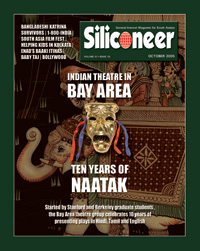
OCTOBER 2005 |
|
||||||||||||||||||||||||||||||||||||||
|
EDITORIAL:
INDIAN THEATRE IN THE BAY AREA Staging live theatre is one of the most challenging of performing arts. So it is no surprise that compared to the huge number of classical music and dance concerts that South Asians can enjoy, live theatre is relatively rare in the San Francisco Bay Area. To the great joy of South Asian theatre buffs, that changed when NAATAK was born ten years ago. Over the past decade, this group of theatre enthusiasts have delighted Bay Area theatre aficionados with their superb productions of plays in Hindi, Tamil and English. NAATAK has gone about its work with a passion and commitment to excellence that has drawn avowed admirers who turn up by the hundreds whenever it presents performances. This year, as NAATAK celebrates ten years, we asked founder Sujit Saraf to tell our readers what it has been like to take on a daunting artistic challenge. Sujit writes about his experience with Naatak in this month’s cover story. However, little did expatriate Bangladeshis expect a hurricane of the might of Katrina to hit them when they came to New Orleans, yet that’s exactly what happened recently. When Katrina hit, Bangladeshis were affected like everybody else in the Big Easy. However, just as the suffering depended on how poor or rich you were, Bangladeshis, being overwhelmingly of modest means, faced enormous hardships. For students or undocumented workers, their circumstances are even more fraught. Partha Banerjee, a veteran immigrants rights activist, talked to many of the survivors of Katrina who have fled New Orleans. Some have lost everything they have, and are not sure how they are going to rebuild their lives. Bangladeshis in Baton Rouge have reached out with a helping hand, but many are themselves stressed by the huge influx of refugees. Partha writes a poignant article about the plight of the Bangladeshis who fled New Orleans after Hurricane Katrina lashed the city. But don’t jump into hasty conclusions. Started single-handedly by an expatriate Indian family in Los Gatos, Calif., a few years ago, the group now supports several schools in some of the most deprived areas in West Bengal. Jaya Basu writes about the nonprofit which began its first project in the slum of Atghara in Kolkata. It started with 13 children. Now Promise supports 60. It has also improved the quality of its services. It provides the children with two nutritious meals a day instead of one, and has hired three more teachers to tutor the children. Promise will sponsor one young student to go to Jadavpur University to study engineering. It may sound like a drop in the bucket in terms of the huge needs of the impoverished, but it is nevertheless a heartwarming, inspiring story of compassion and commitment. Promise Worldwide has managed to cross a crucial hurdle – the moral and social apathy of the privileged – for which we warmly commend it. COVER STORY: Ten Years of NAATAK: Bringing Indian Theatre to the Bay Area By Sujit Saraf Ten years ago, seven people met at the International House of the University of Berkeley, writes Sujit Saraf, who helped found NAATAK, which celebrates 10 years this December with its 22nd production. In the intervening years it has produced plays in Hindi, Tamil and English as well several films. 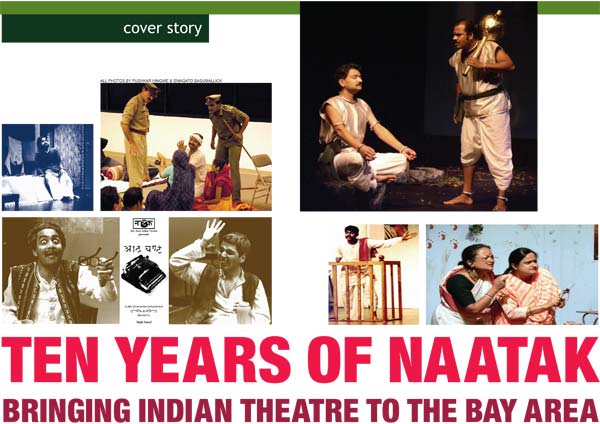 Scenes from NAATAK plays: Clockwise from top left: Sujit Saraf in Mohan Rakesh’s “Aashaadh Kaa Ek Din” (Apr 1998); Vijay Rajvaidya, Monica Mehta Chitkara, Harish Sunderam Agastya, Shobhna Upadhyay and Navjoti Sharma in Bhisham Sahni’s “Muavazey” (Nov 2004); Harish Sunderam Agastya and Aniruddha Bhosekar in Sujit Saraf’s “Tathaa Kuru” (Feb 2004); Ranjita Chakraborty and Monica Mehta Chitkara in Jaywant Dalvi’s “Arey Shareef Log” (Jun 2005); Parthasarathy Mamidipudi in Vijay Tendulkar’s “Khaamosh! Adaalat Jaarii Hai” (Feb 1996); Rajiv Nema (left) and Alok Kuchlous (right) in Sujit Saraf’s “Aath Ghante” (Feb 1997). NAATAK began in the fall of 1995, when a friend and I started looking for ways to indulge our love of theater. We had fond memories of plays we had staged while in college, and we wondered if it was possible to re-create those days. The Bay Area was home to many community organizations and cultural festivals, but we found no group focused entirely on theater, on the reading and staging of full-length plays. It became obvious that if we were to regularly participate in plays, we would have to start our own theater group. We decided that the most efficient manner of creating a theater group was to simply stage a play, and hope that the group would form itself around the event. So, instead of announcing the formation of NAATAK, we announced an audition for Vijay Tendulkar’s Khaamosh! Adaalat Jaarii Hai. We sent out emails, posted notices on newsgroups, and hoped for the best. On December 2, 1995, seven people collected in a lounge in International House, my dormitory at Berkeley. We read the entire play, slowly, over four hours. In the next audition, held the next day, we attracted a few more people, and I assigned roles. We were unable to find a full cast through our auditions. We also had no idea how many people would come to watch our play, and we did not yet have a theater. We began rehearsing anyway, and I soon became aware of the challenges we faced. Although most of my actors could speak Hindi fluently, none had read Hindi in the last few years, so they struggled with the script. Then there were the complications of transport and scheduling. Half my cast lived in the South Bay, and the other half in Berkeley. Those in the South Bay were engineers available only on evenings and weekends. Those in Berkeley, including myself, were graduate students without cars. To distribute the inconvenience, we split our rehearsals between the Berkeley and Stanford campuses. Much time was spent on BART trains, getting picked up and dropped off at BART stations, fixing rehearsal times, adjusting those times to accommodate project deadlines, exams, quizzes and semesters. After a few chaotic weekends, we were able to find an opening at Cubberley Theater on February 16, available only because that was President’s Day weekend. We simplified our sets to wooden frames covered with cardboard, and one of my actors manufactured them in his apartment in Berkeley. We varnished and painted the frames together. Through a combination of spamming and cajolement, we were able to sell eighty tickets in advance. On February 16, I was pleased to see a modest queue form at the box office. We staged Khaamosh! Adaalat Jaarii Hai. Two hundred and five people watched the play, and NAATAK was born.
When NAATAK began, I was conscious of the legacy of our theater days in Delhi, where we usually staged British and American plays, such as John Mortimer’s The Dock Brief, Tennessee Williams’ A Streetcar Named Desire and Sam Shepard’s True West. There are many reasons, not all defensible, why theater groups in India insist on staging plays they cannot identify with, but I was certain I did not want to repeat those mistakes in selecting plays for NAATAK. Now that I was actually living in the West, it seemed silly to try and penetrate the mind of Tennessee Williams. How could I stand on stage and pretend to be Stanley Kowalski, when someone in my audience might actually have grown up in the French Quarter in New Orleans? It was one thing to play at being Stanley Kowalski in far-removed Delhi and quite another to do so in Palo Alto, among those who certainly knew better. We decided, therefore, to stick to plays by Indian playwrights.
This distance from our stage characters often extends to our audience which, after all, is the very pool from which NAATAK actors are drawn. I remember the first ten seconds of our first play, Khaamosh! Adaalat Jaarii Hai. The play begins with the entry of Samant, a villager, and Leela Benare, an actress in a visiting drama troupe from Bombay. “This is the hall where your play will be staged,” says Samant as he enters the stage wearing a kurta and a dhoti. As soon as Samant said this, the audience began to laugh. Standing backstage, I was puzzled. Why were they laughing? What was funny? Had Samant’s dhoti slipped off his waist? Had Leela Benare stumbled? Had we already doomed our theater group in its first few seconds? But of course, none of these things had happened, and our audience had not laughed in derision. They were merely amused to see a man wearing a dhoti, they were pleased to hear Hindi spoken on stage, and they were tickled at the sheer improbability of watching a Hindi play in Palo Alto. The experience was novel, so they expressed their approval with laughter. While these were reactions I may have expected, they had nothing to do with the play. They superseded the play and defeated its purpose, at least in that one opening scene. I was disappointed. It appeared that, just because we had staged a Hindi play in Palo Alto and reminded everyone of home, they were prepared to say it was a “great show”, regardless of the quality of our performance. All that was expected of us was the soft scent of nostalgia. How would we ever stage a good play? Fortunately, this was not entirely true. One cannot expect novelty to entertain an audience for two hours, as was proved by the emails, several critical, that I later received. I now realize that we were fortunate. We were not, and still aren’t, professional theater artists. We are engineers and homemakers who love theater, watch plays and stage them. Over the years, we have acquired many of the skills that professionals might possess, but perhaps not to the same degree as people who do this for a living. We have learned a lot on the job, but if our audience had not been forgiving while we learned, we may never have found the will to continue. After ten years, no one finds it amusing merely to be watching a Hindi or Tamil play. No one thinks it funny when a man walks out on stage wearing a dhoti. Our audience expects a full-blown play and is quick to criticize. There are now many more theater groups dedicated to producing good theater, and we are much more confident in our ability to stage elaborate productions. The same non-professional status that undermines our dedication to theater also frees us from the constraints that usually bind a professional theater group. Because NAATAK members do not depend on theater for their livelihood, we are able to select plays that we really like, and stage those plays exactly as we prefer. We are able to remain faithful to our central goal of producing intelligent, thought-provoking plays, and doing so in a tasteful manner. At NAATAK performances, there are no promotional gimmicks, no elaborate speeches, no chief guests, no sponsorships, no banners, no announcements and no exhortations to buy anything. Every show begins with a short introduction to the play, usually offered by the director or producer. Although most NAATAK profits have been given away to other non-profit organizations, the audience is not subjected to a harangue about proceeds going to this charity or that, on the assumption that people come to watch a play on the merits of the play, not the cause it indirectly supports.
NAATAK has grown organically in the last ten years. More than two hundred people have participated in our plays and films. Our vision for the next ten years is that Indian theater will become a regular part of life in the San Francisco area. People will say over dinner,“Let us go and watch a NAATAK play”, just as they go and watch films. Instead of being a rare and occasional indulgence, “going to the theater” will become a common form of entertainment, to be enjoyed with discrimination and taste. And, through it all, NAATAK hopes to continue staging mature, creative plays, again and again, without much fanfare, but with great artistry and craftsmanship. |TOP|
IN AMERICA: Katrina’s Wallop: Bangladeshi Victims in New Orleans - By Partha Banerjee Hurricane Katrina hurt the expatriate Bangladeshi community in New Orleans particularly bad, writes Partha Banerjee. 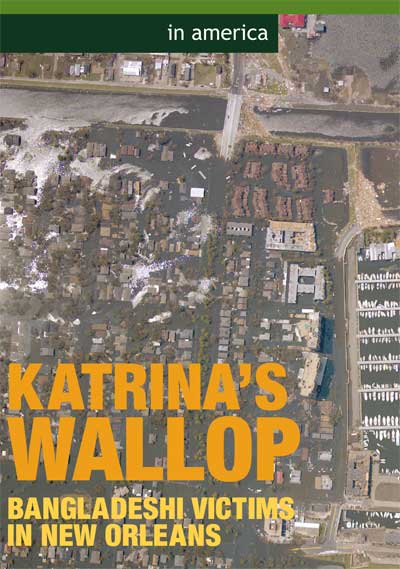 National Oceanic and Atmospheric Administration’s satellite image of New Orleans following the floods unleashed by Hurricane Katrina. (NOAA photo) National Oceanic and Atmospheric Administration’s satellite image of New Orleans following the floods unleashed by Hurricane Katrina. (NOAA photo)When Hurricane Katrina hit New Orleans and destroyed the city Aug. 29, it also devastated the city’s thousands of immigrants and their lives. Many of these immigrants came to the U.S. from countries ravaged by Katrina-type storms and their aftermaths. Now they are faced with similar experiences, all over again. The Bangladeshi immigrants of New Orleans is one community that got wrecked. “We see this back there all the time: havoc, misery because of the big monsoon storms. We never believed we’d see such a catastrophe here that turns our lives upside down,” said Moti, an undocumented immigrant from Sylhet, Bangladesh. He would not disclose his full name. Moti fled Metairie, a northern suburb of downtown New Orleans the Sunday before the hurricane struck. He left behind all the belongings in his first-floor apartment that was inundated with five or six-foot-deep water. He doesn’t believe he’ll be able to put his life back together soon. He believes many others like him had a similar fate. “I didn’t have much in the first place,” he said. “But now, I don’t even know where to begin. I lost it all.” The Bangladeshi students attending various schools including Tulane University also left the Orleans Parish en masse the day before the city was evacuated. Most of them are now staying at friends’ or relatives’ in Houston, Texas, Jackson, Mississippi, Mobile, Alabama, or Baton Rouge, Louisiana. Apart from losing their belongings that include books, term papers, bikes and blankets, these students also lost their meager income, which worries them a lot.
Shahed fled New Orleans in the nick of time only to find himself and some twenty other students huddled in a Bengali doctor’s house in Hattiesburg, Miss., a town that took the hit of the deadly hurricane’s eye. He thought out of an estimated 1,000 Bangladeshis in Greater New Orleans, a few long-time immigrants, lost everything. According to him, a couple of doctors living close to the interstate highway near the hurricane eye saw their houses completely blown away. “We’re lucky to have survived,” Shahed said. “But (in spite of the) generosity provided to us, it’s not the happiest situation. We have to find a way to put our lives back together soon,” he said. Shahed described how the city residents and its immigrant students did not really get any serious warning about the oncoming storm. “Tulane students just got one five- or 10-minute alarm, and basically that’s it,” he said. “We were playing soccer with a bunch of kids even on Saturday. Never thought it was going to be so bad.” Two days later, Hurricane Katrina walloped the city. New Orleans residents, who are used to relocating to nearby places at hearing official warnings, did not know what was coming at them.”
“They tell us now that we can go check on our home in Kenner, but I’m afraid we’d get mugged or something if we went,” she said. “I don’t know what to do. They say houses are being vandalized and the water to drink is not safe. I have a child and I’m afraid.” Hurricane Katrina impacted Bangladeshi immigrants in Baton Rouge, a city about 50 miles northwest of New Orleans. “Our population has suddenly gone up twice, three times because of the people who escaped New Orleans and came here,” Khasruzzaman Chowdhury, a university professor, said. “This is unprecedented—traffic jams and all. Where are they going to put up so many people in grave needs?” Chowdhury and his family had no electricity for nearly a week since Katrina hit Louisiana. “We moved from friends’ to friends’ to eat because we have an electric oven and couldn’t cook,” he said. “But our discomfort is negligible compared to theirs,” he agreed. Chowdhury and his wife are now helping Bangladeshi and other South Asian immigrants to rehabilitate. He’s using his connections to help those who need it. “We’re also reaching out to other poor communities,” he said. “I have students from poor families and they’re in serious trouble.” |TOP| NEWS DIARY: September Roundup  ‘Dead Women’ Elected in Pakistan | South Asia Meet to Be Landmark Summit | Free Rice for the Hungry | Fresh Charges against Lalu Prasad Yadav | Indian Women and HIV | Rape Remarks Stain Musharraf | Sensex Hits New Peak | ‘Dead Women’ Elected in Pakistan | South Asia Meet to Be Landmark Summit | Free Rice for the Hungry | Fresh Charges against Lalu Prasad Yadav | Indian Women and HIV | Rape Remarks Stain Musharraf | Sensex Hits New Peak | 'Dead Women’ Elected in Pakistan Pakistani Police have opened a probe following complaints that two dead women were elected in August’s local elections. The women were elected in two separate constituencies of Upper Dir district of North West Frontier Province.
But the elections were marred by violence and claims of vote-rigging. According to reports. one of the women has been dead for 13 years and the other for three years. Khushalzada Khan, assistant election officer in Upper Dir, told Reuters that fresh voting would be ordered in the constituencies if the women were found to be dead. Supporters of Pakistani President Pervez Musharraf claimed victory in the local elections. But opposition parties and groups like Pakistan’s Human Rights Commission said the elections were marred by extensive vote-rigging.
Indian Foreign Secretary Shyam Saran said foreign ministers representing the seven SAARC nations met on the sidelines of the UN General Assembly in New York recently. “We all agreed the SAARC summit will be an important and landmark summit,” he told a news conference. “We have agreed we should have a substantive agenda ... move SAARC from making declaratory statements to doing some collaborative work.” All SAARC members must agree on Afghanistan’s admission. SAARC, which groups Bangladesh, Bhutan, India, Maldives, Nepal, Pakistan and Sri Lanka, was founded in 1985 with the aim of fostering closer economic and social ties. But tensions between India and Pakistan have hamstrung economic cooperation and development in one of the world’s poorest and most populous regions. The last SAARC summit was in 2003 where leaders agreed to launch a free-trade area from 2006 and draw up a social charter.
Rice, the staple for Bangladesh’s 140 million people, is beginning to get prohibitively expensive ahead of Ramadan after a poor harvest. Officials say a situation of near famine is looming, particularly in the north. Every autumn food stocks run out before the rice harvest in December. Officials say the program reflects the government’s recognition that high prices of rice are hitting the poorest hardest. Keeping rice prices affordable for the country’s poor — the vast majority of the population — is one of the biggest political challenges for any government in Bangladesh. Deputy Food Minister Asadul Habib said the free food distribution program was aimed at ensuring that rice was available to the poor. He said the government expected the free rice to contain rising prices as poor people would not need to rush to the markets to buy food. He said an estimated 20 million people would benefit.
The charge refers to the fodder scam, which first came to light in 1996, when Yadav was charged with embezzling state funds intended to be spent on animal fodder while he was chief minister. The treasuries from which money was allegedly stolen are situated in Jharkhand, which was split from Bihar as a separate state in 2000. Two special investigative courts in Ranchi, state capital of Jharkhand, charged Yadav and others, including former Bihar Chief Minister Jagannath Mishra. In the first case, the court charged Yadav and Mishra with misappropriating $41 million of state funds. A second case accused the two men of illegally withdrawing $200,000 from the treasury in Deogarh. In one of the cases, Yadav insisted on pleading his own case. He said that it was perhaps the first case in India, where the initial complainant had become the accused. The fodder scam had first come to light while he was heading the state government in Bihar, he said. Not only illiterate women, but so-called educated women also are not aware of HIV/Aids. “That is the pity of the situation among women here,” says Dr Deeksha, the medical director of Vasavya Mahila Mandali, which — in addition to running a home for vulnerable women — also works to promote HIV awareness and cares for women in Andhra Pradesh. Sex is still largely a taboo subject in India, which makes education even more difficult, according to Indian Health Minister Anbumani Ramadoss. “We are trying to sensitize the husband in the first phase, saying don’t do this and don’t do that and try to be faithful and abstinent,” he told the BBC. However, Aids activists say the government is not doing enough. “I think it’s pretty much out of hand as far as I’m concerned,” says Anjali Gopalan of the Naz Foundation. “We’re seeing a tremendous rise in numbers of people who are living with HIV.”
Musharraf recently told The Washington Post that many Pakistanis see rape allegations as a way for women to make money and get visas to leave the country. His comments caused an outcry among human rights activists. “Violence against women is a universal problem,” said Kamila Hyat, co-director of the Human Rights Commission of Pakistan. “Many governments have taken serious steps to deal with it. Pakistan hasn’t.” She called Musharraf’s reported comments “insensitive and rather pointless.” “There are thousands of victims of rape in Pakistan,” she said, “and as far as I know, none went abroad” other than a doctor who claimed she was raped by a military officer. Musharraf later backtracked and denied saying that activists profited from making rape accusations, but the newspaper said the recorded interview proved he was correctly quoted.
The Sensex has gained more than 25 percent this year, spurred on by foreign investors who are pumping money into Mumbai’s stock market. Banks were the biggest winners, with the government-owned State Bank of India and private sector ICICI Bank both rising strongly. India’s economy, one of the fastest-growing in the world, is forecast to grow by 7 percent this year, despite concern over rising oil prices. The strong market performance has come as a boost to India’s Congress-led coalition government, which is under pressure from its Communist allies to roll back some of its economic reform plans. Just over a year ago, when the party was voted into office, Indian share prices recorded their biggest fall in a single day’s trading over concerns that the new government would stall economic reforms. “Black Monday” wiped billions of dollars off the value of India’s listed companies. But India has continued to enjoy strong economic growth, lifted by growth in exports and further market reforms. ANALYSIS: Katrina and Mumbai: The View from Delhi - By Siddharth Srivastava The wrath of Katrina, and disaster management in its aftermath has raised troubling questions about the world’s only superpower, writes Siddharth Srivastava. 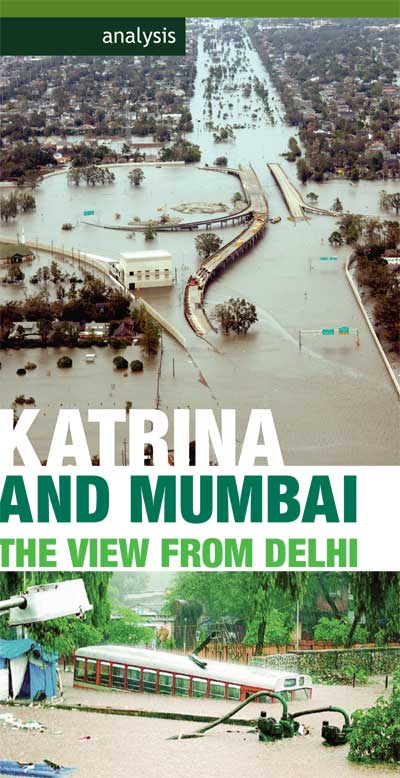 Top: Aerial view of New Orleans after Hurricane Katrina broke open its levees. (U.S. COAST GUARD/ KYLE NIEMI photo) Top: Aerial view of New Orleans after Hurricane Katrina broke open its levees. (U.S. COAST GUARD/ KYLE NIEMI photo)Bottom: A Mumbai BEST bus going under torrential floods. Even as the U.S. has struggled to come to terms with the aftermath of hurricane Katrina that has destroyed New Orleans, there is a sense of shock in India. Pictures of victims begging for food, reports of looting, rapes, racist attacks, an ineffective disaster management routine has revealed the innards of America that many believed never existed. After all, making it to America, the land of opportunities, freedom and quality lifestyle, remains one of the most enduring of Indian dreams. New Orleans is a modern city and a tourist destination. It makes matters worse, when the prediction about the hurricane had already been made the necessary precautions were not taken. Hundreds of thousands have been displaced with thousands probably dead. Damage is estimated at $25 billion and disruption to U.S. refineries has pushed oil prices to record highs above $70 a barrel. The images beamed all over the world along with reports of desperation are generally associated with Africa or less developed countries in Asia. Two pictures displayed prominently by newspapers here spoke of the tragedy with telling eloquence. One is a photo of an African American woman lying dead on the roadside while a police car whizzes past. Another photograph is of a large group of women lunging for food being distributed. Some of the voices continue to resonate and haunt: “I really don’t know what to say about President Bush,” said a 60-year-old Vietnam veteran. “He showed no lack of haste when he wanted to go to Iraq, but for his own people right here in Louisiana, we get only lip service.” “They died right here, in America, waiting for food,” said another affected person. Many in India have been talking about the recent natural disasters in India—the tsunami in December and the unprecedented rainfall in Mumbai in July which was perhaps dealt with much better, now that one can compare disaster management with that in New Orleans. In Mumbai, the government agencies were found severely wanting, but there have been innumerable tales of people pitching in to help citizens with food, shelter and transport that checked casualties. There have been some reports of vehicles stalled in water being burgled, but no arson and looting to the scale that happened in New Orleans. A couple who spoke to this correspondent talked about the help they received when their car was flooded. The locals in the area arranged for their night stay and assured that nobody would harm the car. Two days later, the couple went back to find their car intact. There have been many, many such stories which have been covered on TV as well as the print media. Similar was the case with the tsunami, where the governments of the coastal states actually did a better job in providing relief than in Mumbai, apart from the citizen and private initiatives.
In a reversal of usual roles, India has offered a comprehensive assistance package to the U.S., the world’s largest relief donor. An estimated 70 nations, from Azerbaijan to Venezuela, Afghanistan and Thailand have offered cash contributions to the Red Cross totaling more than $100 million, U.S. Secretary of State Condoleezza Rice has said. The American people, too, are responding with massive donations. India’s three-pronged package attempts to export a combination of materials and expertise, given its experience in handling large-scale disasters. Apart from a $5 million contribution to the American Red Cross, India has offered to send Army medical teams, rather than civilian, given the law and order problems. This is apart from expertise in water purification and consignments of medicines. Many questions are being asked post Katrina: Has America become too obsessed with other countries, ignorings domestic interests of its own? Has the administration gone too far in pursuing its war on terror, its battles in Iraq and geo-strategic games to stamp its might, at the cost of its own people? Has President George W. Bush committed too much resources in the battlefield that has led to the absence of adequate manpower to protect American citizens? Have Bush’s tax cuts to please the rich and corporate America harmed the nation? A news agency has analyzed census data that shows that the residents in the three dozen worst affected neighborhoods in Louisiana, Mississippi and Alabama were disproportionately minority and had incomes $10,000 below the national average. However, issues of poverty and racism are a thorny issue in every society. Mumbai has its share of poor and caste/regional/religion barriers. Yet respect for law and individual dignity has to be nurtured even within these constraints, especially during a crisis. “What we are seeing in the U.S. is complete chaos,” said Farida Lambe, a social worker involved in relief during the Mumbai floods. “My assessment is that many of the problems arose as the people are not used to facing calamities. They expect complete efficiency and find it difficult to cope if it does not come about.” One has to wonder: Had not the Bush government been so embroiled in the war in Iraq as well as keeping an eye on suspected nuclear weapons in Iran, North Korea, would matters have been dealt with in a better way? While the federal government deserves considerable blame, in fairness, it wasn’t just the federal government that failed Katrina’s victims. Critics are already pointing out that national resources drawn from the American taxpaying public are being spent on warfare in Iraq at the expense of domestic needs. September 11, 2001 changed the U.S. It forced the country to look for the enemy out there, with Saddam Hussein the convenient scapegoat. Most agree that terrorism in the name of Islam has influenced youth around the world, whether in Britain, Europe or America, but the solution does not lie in going for more wars. The rise of Islamic terrorism the world is grappling with today is itself a product of the Cold War played out in countries like Afghanistan. To say that it’s time for the U.S. to learn from countries like India and the United Kingdom may be overstating the point, but it cannot be gainsayed that U.S. disaster relief performance in relation to India and Britain stands in stark contrast to its overwhelming geopolitical superiority as the only remaining superpower strides the world like a colossus. Hurricane Katrina could well be a wake up call, and if it makes American policy makers look inwards, it won’t happen a moment too soon. - Siddharth Srivastava is India correspondent of Siliconeer. He lives in New Delhi. |TOP| SOCIAL WORK: Reshma's Story: Helping Kids Learn - By Jaya Basu For kids in India whose families earn less than a $1 a day, Los Gatos, Calif.-based Promise Worldwide provides education and the priceless hope of a better life, writes Jaya Basu.
Our story is about a small and desperately poor village called Atghara in the Rajarhat Gopalpur municipality in West Bengal—a village that is intruded upon by the expanding metropolis called Kolkata. Jolpara in Atghara is bounded by Kolkata’s international airport and a new multilane expressway, facilities that bring no real long-term advantage to this depressed area. At Jolpara, where the nearest high school is over half a mile away, and the closest hospital is over nine miles away, life goes on without amenities most people take for granted. Opportunities for earning money usually stop at ragpicking.
One organization that provides this is Promise. Promise is a non-profit organization which brings hope to 50 children in the neighborhood. Hope for a better education and the warmth of a full meal. The meal is the immediate attraction. Most families send their children to the Promise project for the free lunch, but there are other long-term benefits. Youngsters like Reshma have to be encouraged, because they suffer from serious economic disadvantages. Reshma’s father, for example, recovered from tuberculosis only two years ago, and now works as a night watchman on very low pay. Studies are of primary importance. All the children go to school. Coaching and careful supervision help them get the most out of their lessons. Apart from this, Promise allows the children to learn discipline and teamwork. The accent is on cleanliness.
After Promise came into the area, women in Jolpara have started to use other water sources to wash utensils. It is the children who have taken civic values and hygiene from the classroom to their homes. Lunch at Promise is a simple but wholesome affair. The daily staple is rice, lentils and vegetables. At the start of the project, available funds permitted only a single banana, a quarter loaf of bread and a boiled egg for each child. Financial assistance may bring further items to the lunch tables here. When lunch over, the children go home to the world outside Promise. They carry with them their dreams and the hopes of the Promise project. Every day, as they go to school, Promise believes that the children have taken another small but significant step towards a better tomorrow. However, there are many more children who await a helping hand.
TELEVISION:
Through Indian Eyes: 1-800-INDIA - A Siliconeer Report The PBS show Wide Angle explored the experience of young Indian women who work 80-hour weeks at call centers in a recent documentary. A Siliconeer report. 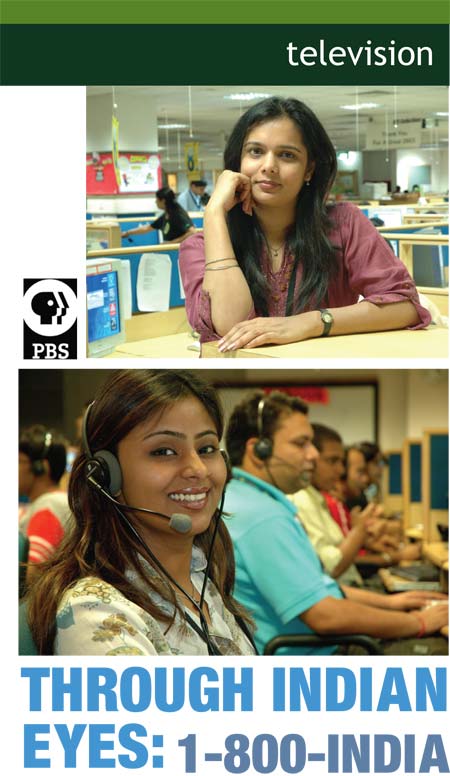 Minal Varma (top), and Ekta Jaiswal (bottom), featured in “1-800-INDIA,” at work in an Indian outsourcing company, GECIS. (ANAY MANN photos) Minal Varma (top), and Ekta Jaiswal (bottom), featured in “1-800-INDIA,” at work in an Indian outsourcing company, GECIS. (ANAY MANN photos)As India emerges as the leader in the rapidly growing global market for white-collar “outsourcing” jobs, up to half a million American jobs may have been “lost” to India in recent years through outsourcing, and some analysts project that the number will soon reach a million, as Indian and Chinese back-office sectors expand by 30 percent a year. In 1-800-INDIA, Thirteen/WNET’s Wide Angle shows the transformation taking place inside India. Traveling to Gurgaon, a suburb of New Delhi and home to India’s first call center, 1-800-INDIA follows four women who work for GECIS, the nation’s largest BPO (Business Process Outsourcing) company, with over 13,000 employees. Profiling these young women working at well-paid, demanding jobs that require long hours, late-night shifts, and Westernized work habits, 1-800-INDIA reveals the personal and cultural impact of this sweeping global trend. The documentary premiered Sept. 13 on PBS. Through the stories of the four GECIS employees, 1-800-INDIA reveals the changes outsourcing is bringing to the evolving landscape of Indian cities and towns, to the Indian economy, and to the aspirations and daily lives of young Indians entering the new globalized work force. “What I love about it is I think it’s given India confidence. Confidence is a huge thing,” says Pramod Bhasin, president and CEO of GECIS and a pioneer of the outsourcing industry in India. 1-800-INDIA producer Anna Cater has produced a wide range of documentaries for ABC Australia, CBC Canada, the BBC, and others. Director Safina Uberoi’s recent film My Mother India, about her Australian mother’s love affair with India, won 11 major international awards including the New South Wales Premier’s Award, Australia’s highest literary award for script writing. Wide Angle anchor Bill Moyers conducted a post-film interview with Clyde Prestowitz, president of the Economic Strategy Institute in Washington, D.C., and author of “Three Billion New Capitalists: The Great Shift of Wealth and Power to the East.” They discussed how the geo-economics of outsourcing are reshaping the lives of Americans, and the opportunities and challenges America faces in the new global economy. Wide Angle is a production of Thirteen/WNET New York for PBS. Stephen Segaller is executive producer. Pamela Hogan is series producer. Andy Halper is senior producer. Major funding for Wide Angle is provided by PBS, The William and Flora Hewlett Foundation, The John D. and Catherine T. MacArthur Foundation, The Jacob Burns Foundation, Ford Foundation, the Miriam and Ira D. Wallach Foundation, Pilar Crespi Robert and Stephen Robert, and Bernard and Irene Schwartz. CINEMA: A Feast of Cinema: South Asian Film Fest - By Ivan Jaigirdar Ritwik Ghatak’s classic Meghe Dhaka Tara, Shonali Bose’s awardwinning AMU, Ali Kazimi’s poignant documentary on the 1914 voyage of Indians on the Komagata Maru, the San Francisco South Asian Film Fest has it all, writes Ivan Jaigirdar. 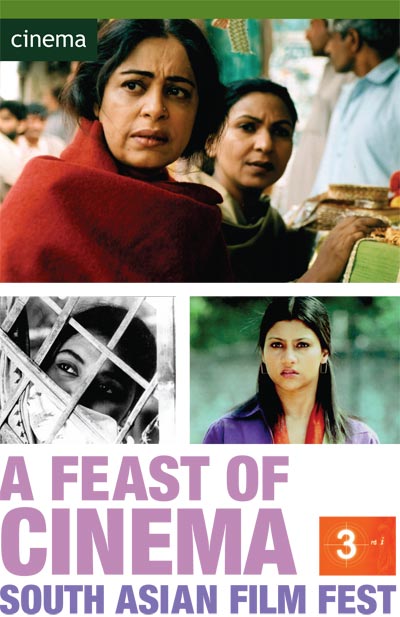 Clockwise from top: Scenes from “Khamosh Paani;” “AMU;” and “Meghe Dhaka Tara,” which will be screened at the South Asian Film Festival. Clockwise from top: Scenes from “Khamosh Paani;” “AMU;” and “Meghe Dhaka Tara,” which will be screened at the South Asian Film Festival.It has been a rich year for South Asian film, and 3rd I’s annual San Francisco International South Asian Film Festival will be showcasing more cutting-edge new films as well as the full breadth of South Asian cinema, including and highlighting works by South Asian women filmmakers. The festival arrives this year Nov. 11, 12 and 13, giving Bay Area moviegoers a sample of classic Indian cinema, hard hitting social documentaries, innovative features and the latest in Bollywood sizzle. SFISAFF features a number of premiere screenings with appearances by filmmakers and stars at a reception at the Castro theatre. The program opens Nov. 11 at the Roxie theatre with a diverse compilation of South Asian short films from the Bay Area filmmakers, followed by Sunset Bollywood, a new documentary which explores the meteoric rise and fall of three of Bollywood’s biggest stars.
So round up all your friends and come on over to enjoy! MUSIC: You’ve Stolen My Heart: Kronos Quartet and Asha Bhosle Evergreen playback queen Asha Bhosle hooks up with San Francisco’s Kronos Quartet to present the deliciously campy hits of the unforgettable Bollywood composer R.D. Burman. A Siliconeer report  The cutting-edge San Francisco-based Kronos Quartet and evergreen Bollywood playback queen Asha Bhosle have joined hands to pay homage to some of the biggest smash hits of yesteryear by Bollywood composer R.D. Burman. 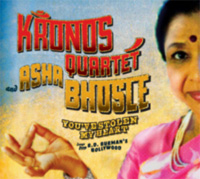 Inspired by Burman and Bhosle, Kronos have launched their new music album, “You’ve Stolen My Heart,” augmenting its acoustic sound with keyboards, percussion, and other instruments, all played by the Quartet members. Longtime collaborators Zakir Hussain (tabla and a variety of other percussion instruments) and Wu Man (Chinese pipa and other stringed instruments) also lend their virtuosity. Inspired by Burman and Bhosle, Kronos have launched their new music album, “You’ve Stolen My Heart,” augmenting its acoustic sound with keyboards, percussion, and other instruments, all played by the Quartet members. Longtime collaborators Zakir Hussain (tabla and a variety of other percussion instruments) and Wu Man (Chinese pipa and other stringed instruments) also lend their virtuosity. Now they are taking their homage to Bollywood to Carnegie Hall in New York, before performing live at San Francisco’s Yerba Buena Center for the Arts Sept. 22 and 23, UCLA in Los Angeles Sept. 24 and the Barbican Center in London Oct. 7. The Carnegie Hall performance in New York is scheduled for April 8.
“Kronos has explored the marriage of music and film for many years, so immersing ourselves in the music of R.D. Burman’s Bollywood was natural,” says Kronos Quartet violinist and artistic director David Harrington. “Burman’s music transcends any categories of ‘Bollywood’ or ‘film music.’ To me, it stands on its own as some of the most inventive, far-reaching, and fun music of the late 20th century. In working with Asha Bhosle, Kronos has experienced not only Burman’s living legacy, but also one of the most talented and generous artists I know of. Asha truly is the Queen of Bollywood.” MUSIC: Pakistan’s Alamgir: Still the King of Evening - By Ras Siddiqui Pakistani pop legend Alamgir Haq’s recent performance deserves kudos for enriching expatriate musical lives, writes Ras Siddiqui, who offers the singer a warm dhonnobad, shukriah, gracias and thanks for taking him on a trip down memory lane.  Pakistani pop legend Alamgir performing at Chandni Restaurant in Newark, Calif. It has been quite some time that we have reported on the legendary Alamgir. It seems like only yesterday when he and a skinny Iranian-Pakistani by the name of Mohammad Ali Shehki ruled the pop charts in Pakistan and were almost dethroned by the late Nazia and her brother Zoheb Hassan from the United Kingdom. But time is relative to those who live their immigrant lives in segments. For some of us, the Pakistani segment (as opposed to the American) cannot be forgotten, thanks to Pakistan’s entertainment industry which once enriched our lives. When some of us left, Pakistan had quite an active film and music industry. I guess that we have to be thankful that the music side is still flourishing there. This chance encounter happened because of three reasons. While talking with Raana Faiz of the Hamrahi Radio Program that is well known in the San Francisco Bay Area, I came to know of Alamgir’s upcoming performance in the area. It had been years since our last meeting on a boat ride to the Golden Gate Bridge, where more than a book was launched (so to speak) by our local Urdu poet Javaid Sayed. The second reason was that the hosts of the party were quite accommodating to our inclusion. And last but not least Mrs. Farah Siddiqui is also a big fan of Alamgir, a legend of Pakistani pop music. So without hesitation, Farah and I left for the Chandni Restaurant in Newark Sept. 2. We try never to pass on the chance of the combination of good food and great entertainment. And on this evening we were not disappointed in either department. We met the bespectacled “young man” while he was discussing his music with the sound engineer. I write “young man” here because like a number of other entertainers, Alamgir looks just about the same as I saw him last about a decade ago. We conversed a little and even exchanged a few pleasantries in Bengali, but easily judging my limited vocabulary in that language he switched to Urdu and English. His latest city of residence is Atlanta. Alamgir started his performance by asking everyone to stand up and observe a moment of silence to remember the victims of Hurricane Katrina. His first two songs were dedicated to the wedding couple. The third, a ghazal “Paas Aa Kar Koi Dekhe to Pata Lagta Hai” was quite moving as was the “Kabhi Tum Idhar Se Guzar Ke To Dekho.” But it was with his presentation of the late Ahmad Rushdi’s “Ko Ko Korina” that a certain transformation took place on stage. The glasses were gone and Alamgir was the King of the Evening. The first of two evening songs presented was the ballad “Shaam Sey Pehle Aana” where he pulled out his favorite harmonica and played it in between the lines. And with “Maine Tumhari Gagar Se Kabhi Paani Piya Tha” his control over the attention of the audience was complete (Gori Tum Woh Din Yaad Karo). Not to disappoint fans from across the border he sang his version of Bollywood’s “Main Hoon Na” and for local Americans an English number “Where do I begin” from the movie Love Story. But our favorite and the next song that launched his career, “Dekha Na Tha” which electrified us.
One of his most famous songs from the Platinum Jubilee movie Aina, “Mujhe Dil Se Na Bhulana,” brought back many memories as did his Spanish number “Quanta La Mera” (Plus Albela Rahi) his first song on TV. “Nasha Yeh Pyaar Ka Nasha” with its heavy disco beat was very energetic. And last but not least the song that some of us traveled many miles to hear, “Yeh Shaam Aur Tera Naam” made our day. We were there for more songs and Alamgir was still going strong with a tribute to Ghazal legend Mehdi Hasan as we were leaving, but we stop this writing at “Yeh Shaam” because it made Alamgir an inseparable part of Pakistani pop. Alamgir Haq deserves kudos for enriching our musical lives. Dhonnobad, shukriah, gracias and thanks. It was just great to take a trip down memory lane with you at this program and to reflect back on a time when guided by our youth and once lofty ideals we left our homes for America. And now after all these years, we think back and can only smile as Alamgir, once the King of our Pakistani evenings (shaams) makes both Bangladeshis and Pakistanis think about their home countries while living here in North America. THEATRE: Baby Taj: Love in Agra - A Siliconeer Report Playwright Tanya Shaffer explores the many splendored, bittersweet fruits of love in a cross-cultural comedy set in Agra in her upcoming play. A Siliconeer report.  Left: Lesley Fera (l) and Sunita Param in “Baby Taj.” Right: Sam Younis (l), Lesley Fera and Sunita Param in “Baby Taj.” The romantic Taj Mahal is the next assignment for Rachel, an American travel writer whose failed romances have led her to ask: Why not have the baby she craves — on her own? She finds an unexpected answer among the glittering legacies of India’s past, discovering new truths about love, family, and commitment. Alive with the vivid sounds and vibrant colors of a remarkable country, Baby Taj is a play that is a comic tale of mischievous matchmaking. Written by Tanya Shaffer, the author of the Bay Area hit Let My Enemy Live Long, the play premieres at TheatreWorks in Mountain View, Calif., this month. It’s a landmark cultural breakthrough of sorts, because it’s rare for mainstream American theatre to set plays in India, and Baby Taj is set for the most part in Agra, with a substantial Indian American cast. Rachel is a thirty-seven year old single Jewish straight woman who wants to have a child. She makes a pact with her best friend Anjali, a single Indian lesbian, that they will both become pregnant and raise their children together. On the eve of Rachel’s insemination by anonymous donor sperm, she becomes paralyzed by doubt. A passionate travel junkie, she sets off on a solo journey to clear her head and make a decision. She travels to India, where she spends several weeks in the home of Anjali’s extended family. The contrast between Rachel’s life in the U.S. and the lives and choices of the people she meets in India results in comedy, romance, and deep reflections on the particular choices and challenges Rachel faces as a Western woman at this moment in history. Baby Taj has had public readings in Berkeley, Calif. in New York City and in Mountain View, Calif. Tanya Shaffer is a writer, actor, solo performer, theatre producer and a travel buff,, with a penchant for turning her travels into art. She has toured to over forty cities with her solo show Miss America’s Daughter and her play Brigadista. THEATRE: ENAD's 'Baaki Itihas": Bangla Theatre in the Bay Area Bay Area Bangla theatre buffs had a rare opportunity to enjoy a superb production of a play by Badal Sircar. A Siliconeer report. 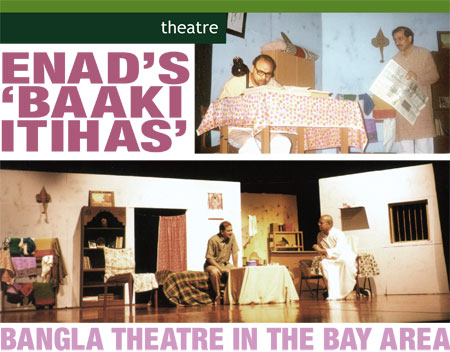 Above and below: Scenes from Enad’s performance of “Baaki Itihas” Above and below: Scenes from Enad’s performance of “Baaki Itihas”Bay Area –based Bangla theatre company ENAD presented two superb performances of Badal Sircar’s classic Bangla play Baaki Itihaas Sept. 10 in Palo Alto, Calif. This is ENAD’s seventh production. Baaki Itihas is a play that is best described as an exercise in psychoanalysis. A headline in a newspaper stimulates a thought experiment between a literary couple. What begins as an intellectual exercise, soon morphs into a stifling commentary on mankind’s selfish, complacent existence, and on his darkest thoughts—the kind that drives him to write those pages of human history that were best left unwritten. Badal Sircar, an engineer by profession, is a leading theatre personality who rose into prominence with the 1970s wave of street theatre. He revolutionized Bengali theatre with his angst-ridden, anti-establishment plays during the Naxalite movement in a city ridden by traumatic upheavals. Not only does his work revolve around larger social issues involving the masses, he also travels in and around Bengal and takes up issues specific to a particular community or locality and creates plays on the spot. Enad was established in 1999, and staged its first production in 2000. In 2002 we produced its first play based on original script. “We try to produce contemporary, thought-provoking and relevant plays,” the theatre groups says in its Web site. “Our regular audience particularly value our disciplined productions.” DEVELOPMENT: Dialogue with Change Agents: UN AIF Summit - A Siliconeer Report Sun Microsystems COO Jonathan Schwartz and University of Michigan distinguished professor C.K. Prahalad headlined a summit to address India’s challenges in meeting the UN Millennium Development Goals. A Siliconeer report.  Some of the attendees at the UN-AIF Summit. Some of the attendees at the UN-AIF Summit.Philanthropists, social entrepreneurs, non-profit organizations and corporate leaders from across the globe gathered to discuss innovative ways to address development challenges in India at a summit Sept. 23 at the San Jose Convention Center in San Jose, Calif., hosted by the American India Foundation in partnership with the United Nations Millennium Campaign. This is the third annual summit. The summit was open to the public. Featuring Jonathan Schwartz, president and chief operating officer of Sun Microsystems Inc., and C.K. Prahalad, University of Michigan distinguished professor, the summit highlighted issues at the intersection of AIF’s and the UN’s development work in India, including the universalization of elementary education, the use of microcredit to improve women’s livelihood and the HIV/AIDS epidemic in India.
Attendees also examined how progressive leaders in the private, public, and not-for-profit sectors are working to integrate social, environmental, and economic considerations into their organizations. “The American India Foundation and the United Nations Millennium Campaign are committed to promoting the ideals of sustainable development and grassroots movements that are key to the long-term empowerment of the underprivileged in India,” said AIF president Lata Krishnan. “Real progress, whether in education, science, business, or even public policy, requires collaboration across boundaries,” said Sun COO Jonathan Schwartz. “As we seek solutions to some of the world’s most pressing issues, the act of connecting participants accelerates both social and economic development opportunities.” The American India Foundation is an international development organization charged with the mission of accelerating social and economic change in India. AIF has raised over $26 million since its inception in 2001. HEALTH: Dragon Boating: 2,000-Year-Old Sport- By Dr. Marlena Tang Dragon boat racing, a millennia-old Chinese sport, has recently taken off in California and is improving people’s health, writes Dr. Marlena Tang  Dragon boat racing, a sport that began over 2,000 years ago in China, has recently taken off in California as a popular sport and a festive cultural event — and is improving people’s health. It’s an impressive sport to watch: an elaborately adorned dragon boat surges towards the finish line with twenty paddlers pulling hard with every stroke in perfect unison to the drummer’s beat and calls of the boat leader. Dragon boat racing, a sport that began over 2,000 years ago in China, has recently taken off in California as a popular sport and a festive cultural event — and is improving people’s health. It’s an impressive sport to watch: an elaborately adorned dragon boat surges towards the finish line with twenty paddlers pulling hard with every stroke in perfect unison to the drummer’s beat and calls of the boat leader.The sport evolved from re-enacting a 2,000-year-old legend about Qu Yuan, a scholar and advisor to the emperor of the Chu kingdom who jumped in a river in despair and protest of a corrupt government. According to legend, local fishermen raced out with their boats in an attempt to save him. To prevent his body from being eaten by the fish and “water dragons” they beat their drums and pounded the waters with their paddles and threw rice dumplings wrapped in silk into the river to distract the dragons away from his body. Dragon boating is one of the fastest growing sports in the world. There are over 40 annual festivals held across the United States including major cities such as New York, Boston, Los Angeles and San Francisco. Its popularity is due to its accessibility. The challenge of propelling a 48-foot long, 700 pound boat by 20 paddlers for 500 meters can be met by novice paddlers and the highly skilled, the young and old, male and female. Playing a sport like dragon boating regularly and over a long period of time helps prevent health conditions such as cardiovascular disease, stroke, obesity and depression.
This year Oakland-based Kaiser Permanente, a non-profit health care provider, is sponsoring the 10th annual San Francisco International Dragon Boat Festival, organized by the California Dragon Boat Association. Nearly 100 dragon boat teams, each with 20 paddlers, are expected to participate in the races, drawing a crowd of over 15,000 spectators. Brian Soo, senior physical therapist at Kaiser Permanente San Francisco and a rower on the Kaiser Permanente dragon boat, says dragon boating is a full-body exercise, requiring all-out effort for up to 3 minutes. He recommends that paddlers prepare for the race by exercising regularly to build muscle strength, cardiovascular strength and flexibility. “You need to have strong arms to grasp and control the paddle, a strong torso or core to rotate and drive the paddle through the water, strong legs to brace yourself in the boats, and a strong mind to focus on timing,” he said. Kaiser Permanente is sponsoring the event as part of its healthy living campaign that encourages all Californians to thrive every day. Activities like dragon boat racing can be fun, social and great exercise — and even incorporate healthy ancient traditions. |